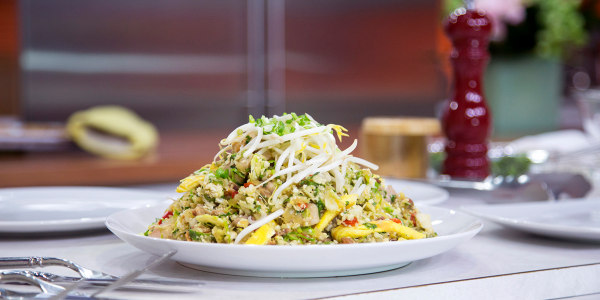Pantry Staples for Paleo Vegetarian Diet
At first glance, the paleo diet may sound ideal for meat lovers.
Versions of the diet are called the caveman diet or the paleolithic diet because you're supposed to be eating foods that were available to our prehistoric ancestors. Think things that can be hunted and gathered like meat, produce and nuts. You'll avoid foods like dairy and grains that humans started eating after agriculture and manufacturing came to be.
But carnivores beware. Dietitians say just because steak and eggs are allowed, doesn't mean you should be loading up on meat all day long at every meal. Here is what you need to know:
What is the paleo diet?
The term paleo diet was coined by Loren Cordain in his 2002 diet book, "The Paleo Diet" (a revised edition of the book was published in 2010). It is based on paleolithic nutrition theory, which posits a lot of chronic disease (like cancer and heart problems) became more common after the advent of agriculture and the industrial revolution, according to anthropologic evidence.

What does the research say about the paleo diet?
The science on the topic is murky at best.
While some studies do show people can reap some health benefits by switching to a paleo-style diet, researchers say the jury is still out on whether those benefits are any better than switching to other healthy diets that have been more thoroughly researched.
For example, a 2015 review published in The American Journal of Clinical Nutrition showed that studies that compared paleo eating with diets with dairy, legumes and grains, revealed that people eating paleo were better able to lose weight, improve glucose tolerance, lower triglycerides and control blood pressure and appetite.
But the story gets more complicated when you look at the trials more closely, explained Deirdre K. Tobias, ScD, associate epidemiologist at Brigham and Women's Hospital and assistant professor at Harvard Medical School and Harvard T.H. Chan School of Public Health. The diets with legumes and grains (the "control" groups) were somewhat high in processed foods. And everyone in those trials had risk factors for metabolic problems to begin with. So it's tough to say with certainty that the benefits they saw could really be attributed to paleo eating. "Was it instead that those benefits came from cutting out processed foods and ramping up fruits and vegetables?" Tobias asked. "Because there are so many aspects of the diets being altered, it is virtually impossible to attribute any one component of the patterns to its success."
Also, a lot of other components of our lifestyles have changed since the caveman era. So linking the advent of chronic disease to specific foods is still fairly theoretical.
What will I eat on a Paleo diet?
Any paleo-style diet includes:
- meat
- eggs
- fruits
- vegetables
- nuts and seeds
Some versions allow for limited quantities of non-paleo foods like grains, dairy, legumes and other processed foods. Cordain's original paleo diet recommends following the 85-15 rule, meaning that 85 percent of the food you eat should be paleo and 15 percent can be non-paleo. Choosing a modified version of the diet can make it much easier to stick with long-term, said said Amy Shapiro, RD, CDN, founder and director of Real Nutrition in New York City.
You'll avoid foods that humans started eating after agriculture and manufacturing came to be, including:
- dairy
- legumes
- grains
- processed sugars
- many foods that come in packages

Samantha Okazaki / TODAY
What a day on the paleo diet might look like:
Here's a sample meal plan from Shapiro that suggests what a day on paleo could look like:
- Breakfast: Frittata made with whole eggs, mushrooms, asparagus and dill
- Lunch: Salad with grilled chicken, avocado, roasted squash and spinach
- Snack: Apple slices (or celery) with nut butter and cinnamon
- Dinner: Roasted salmon with Brussels sprouts, baked sweet potato and olive oil
- Dessert: Avocado chocolate pudding
Are grains and beans are really that bad for me?
Organizations like the World Health Organization and U.S. Department of Health and Human Services regularly review nutrition evidence to come up with healthy eating guidelines. Both groups consistently report that whole grains and legumes are generally associated with lower risks of obesity, type 2 diabetes, heart disease, stroke and cancer.
If you're improving the quality of your diet (meaning you're eating more whole, nutrient-dense foods and minimizing processed foods) by switching to a paleo diet, you'll likely see benefits. But there's not evidence to show that over the long-term you'll see more benefits than if you had switched to another healthy diet that includes grains and legumes (like the Mediterranean diet or plant-based eating), Tobias said.
What about all that red meat?
It's important to consider that there's a pretty substantial collection of nutrition research that suggests eating a lot of red meat, particularly processed red meats (like sausage, ground beef and bacon), is linked to worse health outcomes when it comes to things like heart health and cancer. If switching to a paleo-style diet would mean substantially increasing the amount of red meat in your diet, Tobias said, "it could actually put you at a higher risk for those health problems."
The paleo diet is similar to:
- Whole 30, which also excludes grains, legumes, dairy and sugar.
- Keto diet, which also excludes whole grains and legumes. The diet allows dairy, but not fruit or starchy vegetables.
- Pegan diet, which combines the principles of the paleo diet and the vegan diet.
- Atkins diet, which limits but doesn't eliminate grains, legumes and sugar.
Is the paleo diet effective long term?
If you focus on whole foods that are nutrient-dense, the paleo diet can be a healthy one, Shapiro said. But a lot of people end up leaning a little too heavily on animal proteins when following a paleo-style diet because they feel like they won't be full from the other foods (like fruits, vegetables, nuts and seeds) the diet allows, she explained. "Then we run the risk of consuming too much saturated fat." If adopting the diet means upping your red meat consumption, it's likely not a good move for your long-term health.
You'll also be cutting out whole grains and legumes, both sources of fiber. Vegetables and fruits also contain fiber, but most people will find they'll need to make a pretty concerted effort to get to the recommended intake of fiber in a day (for adults, approximately 25 grams for women and 38 for men).
Before making the switch to paleo, be sure to talk to your doctor who can recommend the best diet for you based on your specific health needs.
Sarah DiGiulio is a New York City-based writer and editor who covers psychology, mental health, fitness and sleep, among other health and wellness topics. She's written for Prevention, Good Housekeeping, HuffPost, Real Simple, Health Magazine and more.
Pantry Staples for Paleo Vegetarian Diet
Source: https://www.today.com/health/what-paleo-diet-here-s-everything-you-need-know-t198672